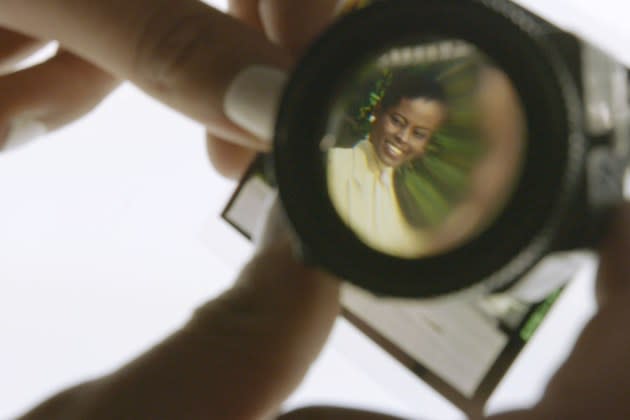‘Seeking Mavis Beacon’ Review: An Enlightening Debut Doc Dives Into the Past to Ponder the Digital Future

If you came of age during the height of computer typing programs, the name Mavis Beacon will conjure the image of a pixelated Black woman with a honeyed voice. You might remember her introduction, delivered in a dulcet tone: “Welcome to typing class, I’m your teacher Mavis Beacon.” She was an encouraging presence in the ’80s, reminding you that, with Mavis on your side, you could do anything — especially learn to type.
But who was Mavis Beacon? Is the person who helped acclimate generations to a requirement of the computer age real? In Seeking Mavis Beacon, a frenzied and enlightening documentary, filmmaker Jazmin Jones embarks on a Searching for Sugarman-style quest to find the actual Mavis Beacon. She’s joined by her associate producer and friend, Olivia McKayla Ross, a young woman whose shifting relationship to the internet becomes a key plot point. Together, Jones and Ross dig into web archives, search physical databases and conduct interviews in order to compose a portrait of an iconic figure.
More from The Hollywood Reporter
Technically, Seeking Mavis Beacon, which will be distributed by Neon, is a documentary. But the film also plays with elements of fiction. There are characters and staged scenes. Fanciful interludes jolt us out of complacency. Depending on your patience for whimsy, Seeking Mavis Beacon might inspire exasperation or admiration. For this critic, it was, for the most part, the latter. There were moments watching Jones’ film that I couldn’t help but think of Paul B. Preciado’s Orlando, My Political Biography, another project that stretched the bounds of documentary to negotiate fact, fiction and myth. Jones’ film uses Mavis Beacon, as Preciado did Virigina Woolf, to ask urgent questions about the digital age and the failed promises of the tech revolution.
Seeking Mavis Beacon opens with a ritual under the starry night sky of Los Angeles: Two people costumed in clothes that look pulled from Puck’s closet wheel a whiteboard onto the street. They proceed to set parts of it on fire, starting with a sheet that reads “Term Notice.” With this almost mythic introduction, a strange trust between viewer and director is established.
The film cuts abruptly to the desktop of the Microsoft Windows operating system — the two-dimensional green hills against an eternal clear blue sky. It’s here among the cheeky file names gesturing to the scope of Jones’ project that Seeking Mavis Beacon takes shape. As if the computer is operated by a phantom user, videos about Mavis Beacon start to play in quick succession. They’ve been culled from all corners of the internet and elsewhere — YouTube videos, TikToks, home archives, old school webpages built on basic HTML — and they all demonstrate how many people feel indebted to Mavis Beacon.
Jones’ investigation is driven by the mystery of Mavis Beacon, but it’s not the only topic the director and her co-conspirator are interested in. Interviews with experts like curator Legacy Russell (author of Glitch Feminism) and interdisciplinary artist Stephanie Dinkins (she creates work about artificial intelligence) signal the doc’s broader interest in the failed promises of the internet. With the confidence of digital natives, Jones and Ross embrace new terminology — internet doula, glitch feminism — that expand how we process the role tech plays in our lives. As most of the world cheerleads the potential of AI, society is at risk of blindly embracing the technology without considering potential pitfalls. This perspective amplifies the stakes of the documentary.
Through Seeking Mavis Beacon, Jones and Ross also remind us of when the internet was simpler. Their documentary’s internet-rabbit-hole structure and aesthetic — the aged Windows desktop, the old HTML websites, the folders of iMovie videos — recall a time when the web was a playground of connection instead of a waste bin of advertisements. Remember when even the sound design inspired excitement? The charming drone of a dial-up tone has been replaced by Slack pings, text message buzzes and an iPhone alarm designed to activate our fight or flight senses.
What about Mavis Beacon? Do our adventuring documentarians ever find her? Jones and Ross look everywhere. They interview the creators of the Mavis Beacon Teaches Typing program, who seem cagey and suspicious of the two Beacon fans. Details of a lawsuit emerge, but they are hazy and hard to follow. Here the documentary’s lattice-like structure hinders rather than helps our understanding of the investigation’s realities. What does become clear is that Renee L’Esperance, a Haitian model, perfume saleswoman and the face of Mavis Beacon, may not want to be found. As this realization dawns on Jones and Ross, their documentary, like the best late-night internet rabbit holes, finds another question: What does it mean to maintain privacy in a world that feels entitled to public profiles?
With this detour, Jones and Ross confront the idea of privacy and the ethics of their own investigation. Should they stay the course with their true-crime-style mission? Or should they honor what they know about L’Esperance? Like Robert Greene (director of docs Procession and Bisbee ’17), Jones uses her documentary as an interrogation of established genre practices. That Seeking Mavis Beacon doesn’t shy away from these questions is why the documentary is gripping. But there are moments that risk losing audiences. Sections in which Jones and Ross create new narrative strands about their personal lives open lines of inquiry that would have worked better in a different project.
It’s impressive that Jones and Ross remain vulnerable in their pursuit of Beacon/L’Esperance, but what inspires the most here is the depth of the filmmakers’ curiosity. Beginning as a search for a typist who changed lives, the film ends up offering us new tools to understand how we live.
Best of The Hollywood Reporter

